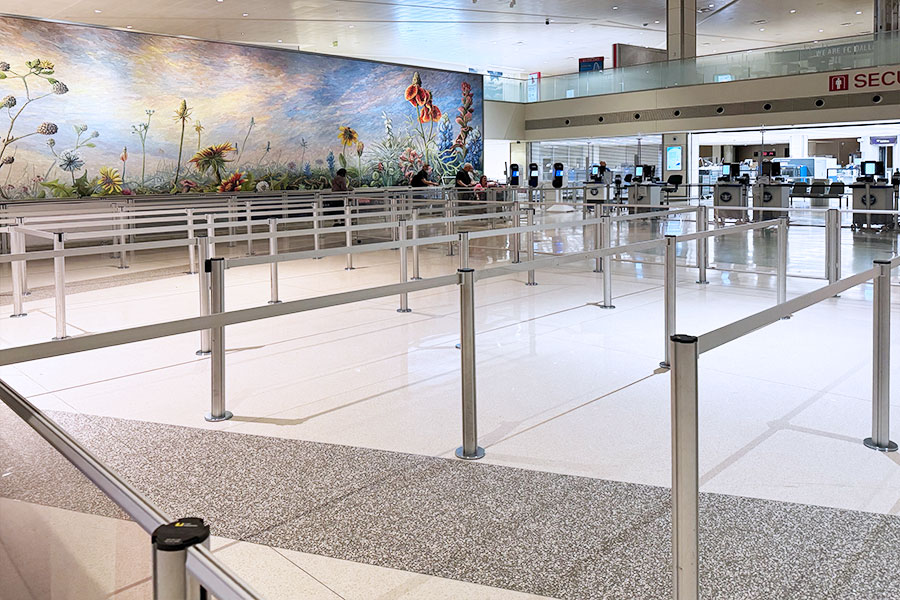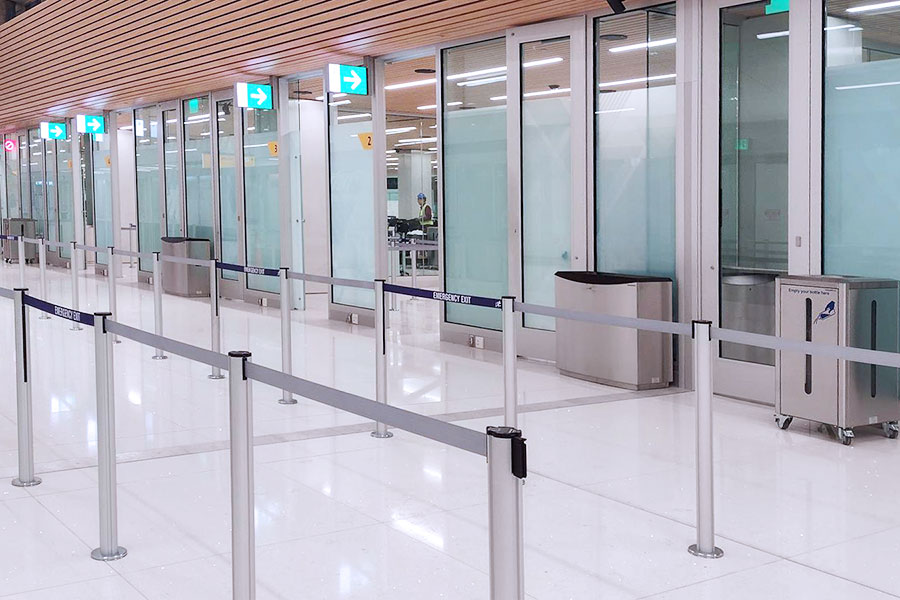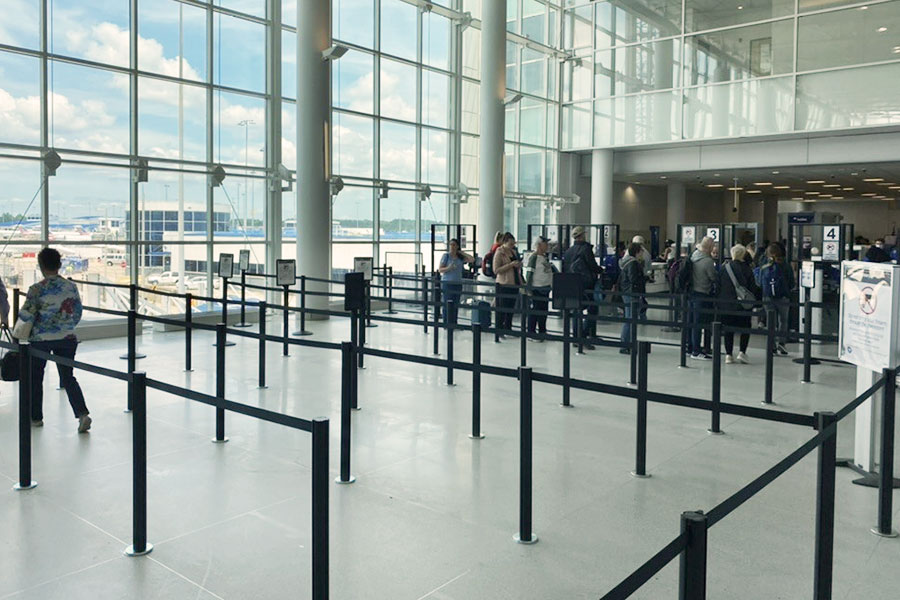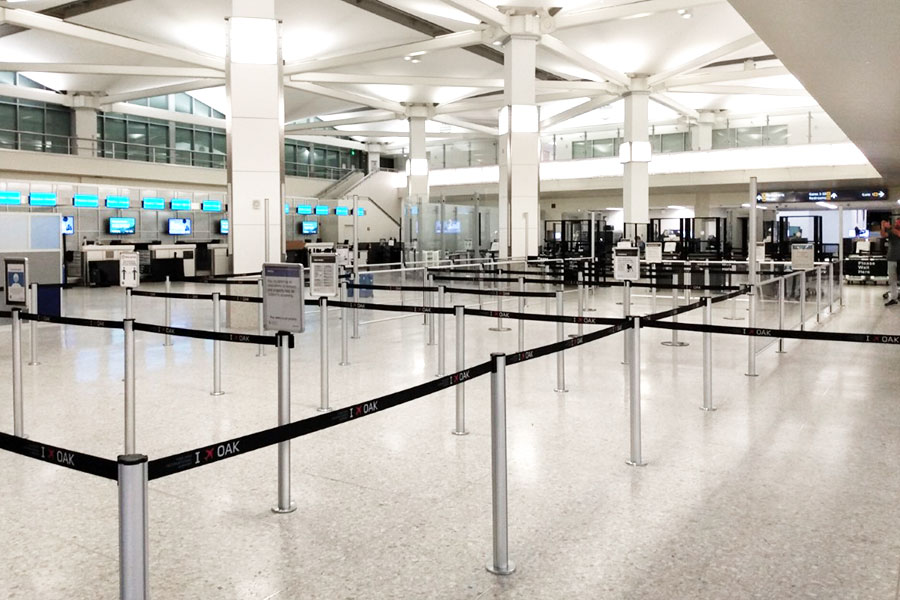
From Bottlenecks to Breakthroughs: The Transformative Power of Magnetic Stanchions
The air travel industry is at a turning point, with demand projected to double to 8.2 billion passengers by 2037. Airport executives face growing pressure to manage existing space, tight budgets, and expectations for seamless passenger experiences — all while upholding strict safety standards.
Stable, space-efficient magnetic stanchions are an innovative solution gaining traction in modern queue management. Unlike permanent stanchions that require floor drilling and offer limited flexibility, the stanchions feature a magnet-embedded base that securely attaches to steel plates glued to the floor, enabling quick installation and easy reconfiguration. And, unlike portable stanchions, which may move around over time, magnetic stanchions provide secure placement even in high-traffic areas, all while being easily removable for cleaning or layout changes.
At the 2024 Airports Council International - North America Conference, Lavi Sales Executive Paul Herren presented how magnetic stanchions are optimizing passenger flow, security, and flexibility — and boosting airports’ bottom lines. “Lavi’s magnetic stanchions are sparking real excitement,” says Paul. “There’s strong interest in how this innovative solution streamlines queues and drives operational efficiency, and is also integral to automated Smart Guidance Technology, which is gaining traction in airports.”
The Notable Impact of Magnetic Stanchions in Airports
Lavi’s magnetic stanchions enhance security, redefine queue management, and enrich the airport atmosphere.

Enhanced security and compliance
One of the world’s busiest airports, serving 77.8 million passengers annually, incorporated Lavi magnetic stanchions to create a modern, state-of-the-art security checkpoint.
“Efficient queuing not only enhances passenger safety, but also empowers TSA teams to operate at their best,” Paul explains.
“For example, if the TSA deploys its canine unit — widely regarded as the most effective detection tool — magnetic stanchions paired with post and panel barriers create the unobstructed space needed for them to operate without the dogs getting distracted.”
“And in an emergency, with 1,000 people in a room, integrated emergency egress gates ensure a safe and efficient evacuation, fully aligned with fire marshal and TSA requirements.”

Consistency and visual appeal at every touchpoint
When a busy regional airport in California faced issues with crowds and queues stretching from ticketing to the parking area during peak hours, Lavi magnetic stanchions streamlined operations by providing a well-organized and consistent queue. “Whether it’s for Frontier in the morning or Southwest in the afternoon, the uniform design ensures smooth operations and passenger confidence,” says Paul.

Sustainable, space-saving solutions
As airport executives prioritize environmental responsibility, they’re seeking solutions to increase capacity without expanding physical space. This sustainable approach minimizes the need for additional utilities, staffing, and energy consumption typically required for traditional expansion projects.
"Our magnetic stanchions have a significantly smaller footprint — just 5.5 inches wide compared to the typical 14-inch base,” Paul says. “This allows airports to add extra lanes in the same space.”
“Our stanchions not only optimize capacity, but enhance orderliness and aesthetics, eliminating the clutter of larger, portable barriers that people often bump into. It’s functionality and sustainability combined.”

Enriching experiences
Sustainable architecture and design is playing an increasingly important role in creating a better passenger experience. Paul recalls a Pacific-Northwest airport that incorporated locally sourced wood ceilings and thousands of live plants throughout the terminal to foster a more welcoming, calming atmosphere for travelers.
Complementing these naturescapes are the clean, efficient queue lines enhanced by the magnetic stanchions. Their modern design not only streamlines crowd movement but also contributes to the overall aesthetic, helping create a more organized and stress-free airport environment.
“When passengers can move through security more smoothly and comfortably, they have more time to relax and enjoy the amenities,” Paul explains. “Instead of rushing to grab a quick snack, they can sit down for table service, enjoy a cocktail, or shop.”
That extra “dwell time” makes an airport much more profitable, with recent research showing that every 10% increase in dwell time is linked to an 8% rise in food and beverage spending and a 6% boost in retail purchases.

Building Dynamic Airports for Demanding Travelers
As passenger volumes soar and airports face increasing demands for efficiency, safety, and sustainability, magnetic stanchions provide both the stability and flexibility to meet those challenges head-on.
Even more, magnetic stanchions enable airports to embrace next-generation technologies like biometric scanning, people-counting sensors, and automated smart gate technology. These advancements are redefining the travel experience by increasing passenger throughput while freeing staff to focus on high-value tasks.
Paul explains, “The challenge is always: How do we efficiently flow passengers through these systems? Magnetic stanchions are the answer. They’re not just tools for today; they’re the foundation for tomorrow’s smart, automated airports.”
Research Cited:
Journal of Air Transport Management. Shopping or dining? On passenger dwell time and non-aeronautical revenues. July 2024. Retrieved from: https://www.sciencedirect.com/science/article/pii/S0969699724000851
SUBSCRIBE
Subscribe to stay up-to-date with new products, resources information and news.
RECENT RESOURCES
Rapid Deployment Crowd Control: JetTrac Portable Barriers For The Biggest Spaces
View4 Psychological Reasons Your Customers Hate Waiting In Line
ViewFrom Bleachers To Bookstores: 4 Campus Crowd Control Solutions
ViewCrowd Control Systems for Large Venues
View








